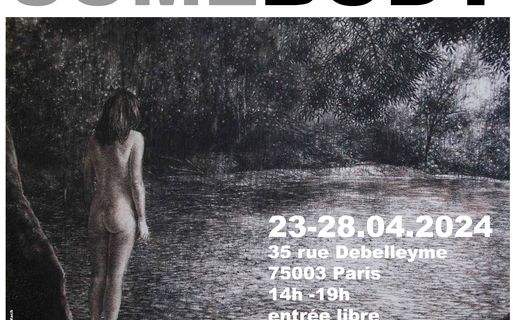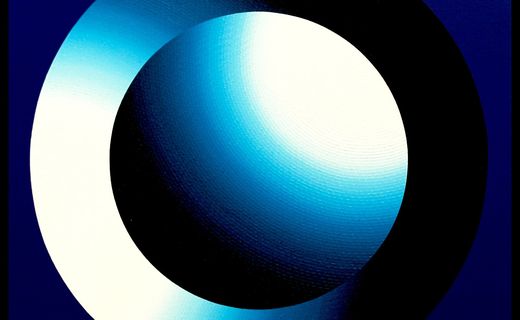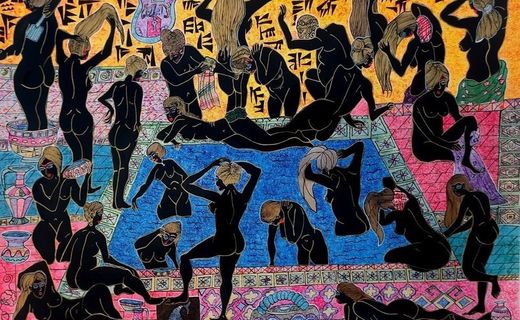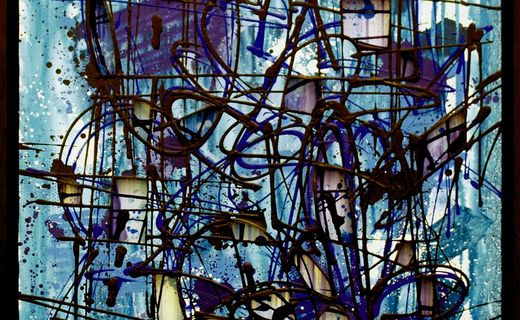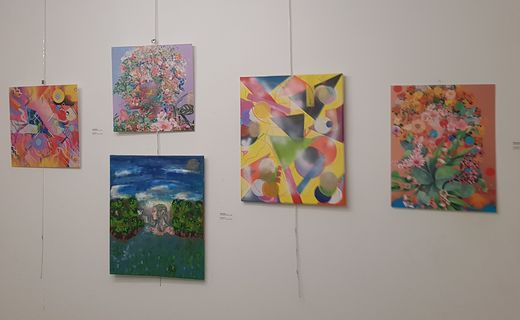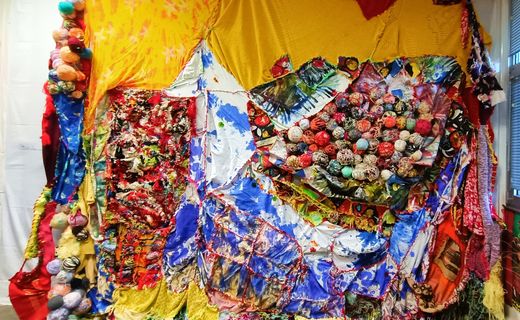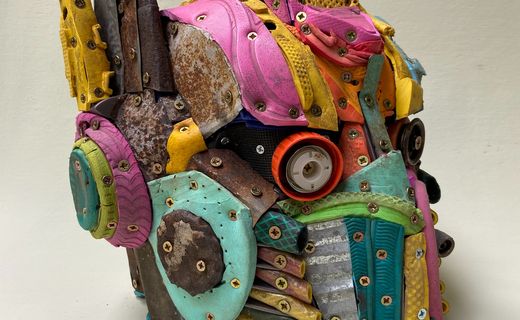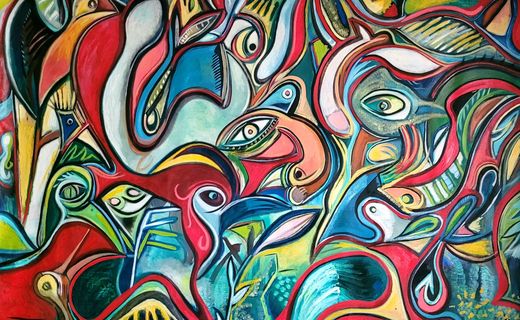Discover around sixty unpublished works by Argentinian painter Sergio Moscona (paintings, drawings, sculptures) on the occasion of his personal exhibition "El Salvador" on the theme of the Savior and exile until July 11 at Galerie Claire Corcia. Sergio MOSCONA was born in 1979 in Argentina. He lives and works in Quito, Ecuador. “My work is nourished by social facts, it is a constant game with what happens, an interaction that shifts and turns things around with the sole intention of trying to approach it from a point where I can, in as far as possible, understand them ”. Sergio MOSCONA BIOGRAPHY: 1989 At ten, he discovered drawing and painting in Silvia Kanonich's studio, which he attended until 1995. 1995 He studied drawing in Beatriz Negrotto's studio. 1997 He discovers watercolor with Guillermo Roux for a year and at the same time follows the philosophy courses of Santiago Kovadloff until 2000. 1998 He works with Jorge Ludueña in his studio in Buenos Aires until his death in 1999. He enters to the National School of Fine Arts of Buenos Aires where he obtained a double degree in painting (2002) and engraving (2004). 2001 Together with the Ecuadorian artist Isabel Espinoza, he founded the artistic collective EL KIEBRE, which promotes cultural exchanges between Paraguay, Argentina and Ecuador. 2003 General curator of the exhibition “Manifestacion sobre el malestar latinoamericano” in the Metropolitan Cultural Center of Quito (Ecuador) for the 25th anniversary of the city as the first cultural heritage of humanity (UNESCO). 2005 He studies lithography for two years in Rafael Gil's studio. First study trip to Europe. 2007 Within the EL KIEBRE collective, he organizes in Ecuador the first Biennial of arts on unconventional supports. 2010 Guest of honor at the World Triennial of Printmaking and Original Engraving in Chamalières, France. 2012 General curator of the exhibition “Lajos Szalay, la linea maestra” at the Eduardo Sivori Museum of Plastic Arts in Buenos Aires, Argentina. PRIVATE AND PUBLIC COLLECTIONS: Museums in Argentina, Brazil, Paraguay, Uruguay, Mexico, England, France, Italy, Ecuador and the United States. CRITICAL FORTUNE: “At 34 years old, this Argentinian prodigy appears as one of the rising figures of contemporary world art. Nourished by the genius of Picasso, he weaves a human epic, brutal and refined, tragicomic and monumental ”extract taken from the article Inhuman comedy written by Marion KLING in Artension n ° 120, 2013.“ The women of the Place de Mai, photos of children brandished like weapons, the parades of soldiers in full uniform, the violence in the streets, are all images of the dictatorship in Argentina (1976-1983), which Sergio Moscona has never ceased to show in his painting. Born in 1979, Moscona lives in Buenos Aires. Coming from the middle class (his mother is a psychoanalyst and his father a doctor), he says he has not suffered directly from the political regime of his country. However, his work seems marked by these years and the social and political context is still present in his paintings. His work is thus part of a narrative tradition in which we can see the legacy of a line of Argentinian artists, politically engaged, such as Antonio Segui (born in 1934), or Antonio Berni (1905-1981). The painters of the “Otra Figuracion” of the 1960s, who are distinguished by the very free treatment of the human figure, will also have a lasting influence on it. Sergio Moscona's motif is man, whom he represents above all in groups, mixed with crowds and processions. However, where the masses, such as totalitarianism forged them, abolish the individual, the crowd, as Moscona shows, not only does not expect the individual but preserves him, raises him above his own. single man condition. Obviously, these bodies, closely mingled in violent or fraternal embraces, reflect in the artist the obsession with the improbable reconciliation between beings. The compressed and backgroundless forms that almost overflow the surface, express this dread. It is in the streets teeming with people and in the buses of Buenos Aires that Moscona gleans his images. To restore the sounds, the movement, the scents, he superimposes them on canvas or paper, in transparent layers and makes them undergo shifts. Through different juxtaposed or entangled shots, he lets the characters appear one through the other, giving rise to unexpected spaces of time (a bit like repentances, those uncertain images painted on the old canvases that we discover in the favor of an x-ray). The whole is rich in the multiplication of plastic solutions offered and surprises by its diversity. At only 36 years old, Moscona has already produced dozens of series, available on all kinds of media, some such as Picasso's “Free Interpretation of Guernica” which has given rise to countless paintings and drawings in Indian ink, in pencil and acrylic. Because the close example is obviously Picasso, whose reference is more than assumed. Extremely mastered, his series of Indian ink drawings seem to be obtained in a single stroke, as the Spanish master liked to do. The lines can be precise, swarming with scratches and details or reduced to the essential and to the limit of abstraction (“Hommage à Guernica”, 2006). But Moscona's drawing virtuosity also draws its source from the observation of the work of Lajos Szalay, a Hungarian artist living in Argentina in the 1950s. Moscona studies his drawing in depth and his admiration is expressed through his own production, to the claimed parentage. The predominance of the line is found in the painted works. Partitioned within fine lines drawn in pencil, the subtle hues of acrylic treated like watercolor; pink, orange, mauve or soft green, soften the expressive power of the drawing, while in other canvases, acrylic is used in solid areas of strong colors, set with thick contours that evoke the composition of stained glass. The result is a work that can be described as “figurative” 1 and expressionist, the type of personage of Sergio Moscona, constituting one of the most characteristic aspects of his work. Men, women, children can seem grotesque: the heads seem too large for the bodies, the noses twisted, the glances hunting. Sometimes the faces express bliss, sometimes they look like death masks. These "mouths" scarred with great jolts which recall primitive societies, these mouths open to the bones of the teeth, in the manner of Bacon, they are both types and individuals, not devoid of a certain prestige. . But there is also something religious in Moscona's work. Both from the point of view of formal tradition - the series “Primary Problems Without Pity” (2009), for example, are not unrelated to crucifixions and descent from the cross - and of content. In this regard, “Broken Flowers”, his latest and new series presented here, seems to evoke the pain of men while waiting for an absolution that is denied to them. Domestic animals often present at Moscona take a back seat. The flower that the characters hold is the common thread of the series. These flowers are withered, broken, like the dreams that men pursue. But don't they also reflect their hope of being forgiven? And don't Moscona's images seek redress for crimes that have left indelible traces? By taking up the techniques and fundamental questions that have crossed the history of Art, Sergio Moscona shows a work overflowing with humanity, turned towards others. While some artists have given up painting, Moscona paints more than ever. With frenzy. With animal joy. Marie-Josée LINOU Chief heritage curator Director of the Riom community museums (Extract from the text dedicated to S. Moscona - Catalog-Musée Mandet - Personal exhibition from November 2015 to March 2016)
Read more



